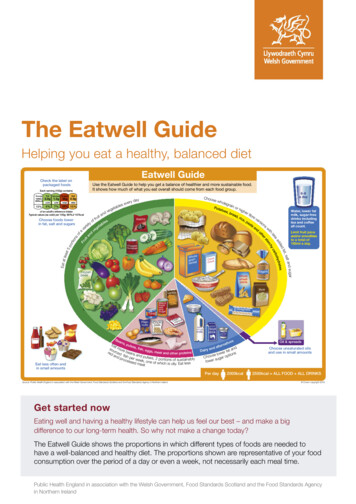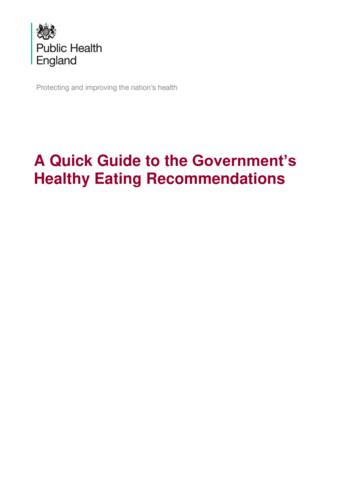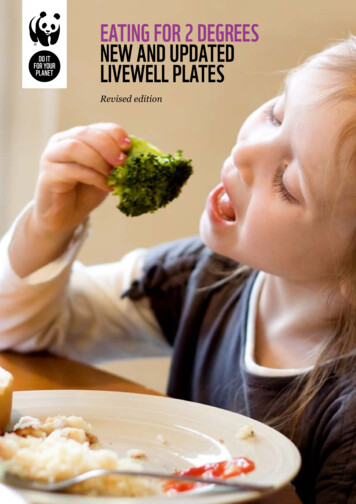
Transcription
The Eatwell GuideHelping you eat a healthy, balanced dietEatwell GuideCheck the label onpackaged foodsUse the Eatwell Guide to help you get a balance of healthier and more sustainable food.It shows how much of what you eat overall should come from each food group.Each serving (150g) containsEnergy1046kJ250kcal13%FatSaturates Sugars3.0g 1.3gLOWLOW4%7%Salt34g 0.9gHIGH38% 15%of an adult’s reference intakeTypical values (as sold) per 100g: 697kJ/ 167kcalndPotatoesdFruitanRaisinsC hoppedt o matoesWholegrain lcereaC o nutsBeanslowersaltandsugarChickpeasSpaghettiL o w fats o f t c h ee s enLeaincemSemiskimmedmilkCrispsSaucBeanLimit fruit juiceand/or smoothiesto a total of150ml a day.sugarBagelsFrozenpeasEat less often andin small amountsotWater, lower fatmilk, sugar-freedrinks includingtea and coffeeall count.andsaltfat,Eat atleast5portionsndit afrufolestyabrieetagvve6-8a dayedsdddrateohysaarblesycithrchtarsheofaChoose foods lowerin fat, salt and sugarsChoose wholegrainor hPotatoesigh, brereadfibre, riceve,prsiasontasaayery ds evelbetavegMEDs, pEaulses, fisso t moreh, egugs, meared rced beanst and other proteinsand pand fishulpses, 2 portionproc er wes of sustainablyekessed mea, one of which is oily. Eat lesstSoyadrinkVegO ilLower fatadsprePlainL o w fa ty o g hu r tesativlternadndanDairyfat awer tionsse loChoo ugar opsrelowPer day2000kcalOil & spreadsChoose unsaturated oilsand use in small amounts2500kcal ALL FOOD ALL DRINKSSource: Public Health England in association with the Welsh Government, Food Standards Scotland and the Food Standards Agency in Northern Ireland Crown copyright 2016Get started nowEating well and having a healthy lifestyle can help us feel our best – and make a bigdifference to our long-term health. So why not make a change today?The Eatwell Guide shows the proportions in which different types of foods are needed tohave a well-balanced and healthy diet. The proportions shown are representative of your foodconsumption over the period of a day or even a week, not necessarily each meal time.Public Health England in association with the Welsh Government, Food Standards Scotland and the Food Standards Agencyin Northern Ireland
ContentsIs the Eatwell Guide for me?3How can the Eatwell Guide help?3When should I use the Eatwell Guide?3How does it work?4Food labelling7Cutting down on saturated fat8Cutting down on sugar8Cutting down on salt10How much food do I need?10Do I need vitamin and mineral supplements?11How can I find out more about healthy eating?14Mae’r ddogfen yma hefyd ar gael yn Gymraeg.This document is also available in Welsh.OGL Crown copyright 20182WG36072Digital ISBN 978-1-78964-249-0
Is the Eatwell Guide for me?The Eatwell Guide applies to most people regardless of weight, dietary restrictions/preferences or ethnic origin.However, it doesn’t apply to children under 2 because they have different nutritional needs.Between the ages of 2 and 5, children should gradually move to eating the same foods asthe rest of the family, in the proportions shown on the Eatwell Guide. Anyone with specialdietary requirements or medical needs might want to check with a registered dietitian on howto adapt the Eatwell Guide to meet their individual needs.How can the Eatwell Guide help?The Eatwell Guide shows the different types of foods and drinks we should consume – and inwhat proportions – to have a healthy, balanced diet.The Eatwell Guide shows the proportions of the main food groups that form a healthy,balanced diet: Eat at least 5 portions of a variety of fruit and vegetables every day Base meals on potatoes, bread, rice, pasta or other starchy carbohydrates; choosingwholegrain versions where possible Have some dairy or dairy alternatives (such as soya drinks); choosing lower fat and lowersugar options Eat some beans, pulses, fish, eggs, meat and other proteins (including 2 portions of fishevery week, one of which should be oily) Choose unsaturated oils and spreads and eat in small amounts Drink 6-8 cups/glasses of fluid a dayIf consuming foods and drinks high in fat, salt or sugar have these less often and in smallamounts.When should I use the Eatwell Guide?You can use the Eatwell Guide to help you make healthier choices whenever you’re: deciding what to eat at home cooking out shopping for groceries eating out in a restaurant, cafe or canteen choosing food on the runAim to fill your trolley with a healthy balance of different types of food.3
How does it work?The Eatwell Guide divides the foods and drinks we consume into five main groups. Try tochoose a variety of different foods from each of the groups to help you get the wide range ofnutrients your body needs to stay healthy and work properly.It is important to get some fat in the diet, however, foods high in fat, salt and sugar areplaced outside of the main image as these types of foods are not essential in the diet andmost of us need to cut down on these to achieve our healthy balance. Unsaturated fats fromplant sources, for example vegetable oil or olive oil, are healthier types of fat. But remember,all types of fat are high in energy and so should only be eaten in small amounts.Many of the things we eat, such as pizzas, casseroles, pasta dishes and sandwiches, area combination of the food groups. For these sorts of food, you just need to work out themain ingredients and think about how these fit with the sections on the guide. For example,if you’re having a cottage pie: the potato fits into the yellow segment; the milk in the mashedpotato fits into the blue segment, the spread in the mashed potato fits into the purplesegment, the meat, meat substitute or beans would fall into the pink segment; the onion,carrots and peas would fit into the green segment.Let’s take a closer look at each of the food groups .A closer look atFruit and vegetablesLots of people know we should be eating more fruit and veg, but most of us still aren’t eatingenough. Fruit and veg should make up just over a third of the food we eat each day.Aim to eat at least five portions of a variety of fruit and veg each day. If you count how manyportions you’re having, it might help you increase the amount and variety of fruit and veg you eat.Choose from fresh, frozen, canned, dried or juiced. A portion is 80g or any of these: 1 apple,banana, pear, orange or other similar-size fruit, 3 heaped tablespoons of vegetables, a dessertbowl of salad, 30g of dried fruit (counts as a maximum of one portion a day) or a 150ml glass offruit juice or smoothie (counts as a maximum of one portion a day).RaisinsC hoppedt o matoes4
A closer look atPotatoes, bread, rice, pasta and other starchy carbohydratesStarchy food is a really important part of a healthy diet and should make up just over a third of the foodwe eat. Choose higher-fibre, wholegrain varieties when you can by purchasing wholewheat pasta,brown rice, or simply leaving the skins on potatoes.Base your meals around starchy carbohydrate foods. So, you could: start the day with a wholegrain breakfast cereal; choose one lower in salt and sugars have a sandwich for lunch round off the day with potatoes, pasta or rice as a base for your evening mealSome people think starchy food is fattening, but gram for gram it contains less than half the calories offat. You just need to watch the fats you add when you’re cooking and serving this sort of food, becausethat’s what increases the calorie content.Why choose wholegrain?Wholegrain food contains more fibre than white or refined starchy food, and often moreof other nutrients. We also digest wholegrain food more slowly so it can help us feelfull for longer. Wholegrain food includes: wholemeal and wholegrain bread, pitta andchapatti, wholewheat pasta, brown rice, wholegrain breakfast cereals and whole oats.Remember, you can also purchase high fibre white versions of bread and pastawhich will help to increase your fibre intake using a like-for-like substitute ofyour family lewheatpastaWholegrain lcereaSpaghettiA closer look atDairy and alternativesTry to have some milk and dairy food (or dairy alternatives)- such as cheese, yoghurt andfromage frais.These are good sources of protein and vitamins, and they’re also an important source of calcium,which helps to keep our bones strong. Some dairy food can be high in fat and saturated fat, but thereare plenty of lower-fat options to choose from.0)Go for lower fat and lower sugar products where possible. For example, why not try 1% fat milkwhich contains about half the fat of semi-skimmed milk without a noticeable change in tasteSemiskimmedor texture? Or reduced fat cheese which is also widely available. Or you could have justSoya milka smaller amount of the full-fat varieties less often. When buying dairy alternatives,drinkgo for unsweetened, calcium-fortified versions.PlainL o w fa ty o g hu r tL o w fats o f t c h ee s e5
A closer look atBeans, pulses, fish, eggs, meat and other proteinsThese foods are sources of protein, vitamins and minerals, so it is important to eat some foodsfrom this group.Beans, peas and lentils (which are all types of pulses) are good alternatives to meat becausethey’re naturally very low in fat, and they’re high in fibre, protein, and vitamins and minerals.Pulses, or legumes as they are sometimes called, are edible seeds that grow in pods and includefoods like lentils, chickpeas, beans and peas. Other vegetable-based sources of protein includetofu, bean curd and mycoprotein; all of which are widely available in most retailers.Aim for at least two portions (2 x 140g) of fish a week, including a portion of oily fish. Most peopleshould be eating more fish, but there are recommended limits for oily fish, crab and some types ofwhite fish. For more information on fish please see www.nhs.uk/Livewell/Goodfood/Pages/fishshellfish. Also www.msc.org/ for more guidance on sustainably sourced fish.Some types of meat are high in fat, particularly saturated fat. So when you’re buying meat,remember that the type of cut or meat product you choose, and how you cook it, can make a bigdifference. To cut down on fat: choose lean cuts of meat and go for leaner mince,cut the fat off of meat and the skin off of chicken, try to grill meat and fish insteadChickPlainof frying and have a boiled or poached egg instead of fried. If you eat morepeasnutsthan 90g of red or processed meat per day, try to cut down to no more thanPlain70g per day. The term processed meat includes sausages, bacon,nutscured meats and reformed meat emTunaA closer look atOils and spreadsAlthough some fat in the diet is essential, generally we are eating too much saturated fat and needto reduce our consumption.Unsaturated fats are healthier fats that are usually from plant sources and in liquid formas oil, for example vegetable oil, rapeseed oil and olive oil. Swapping to unsaturatedfats will help to reduce cholesterol in the blood, therefore it is important to get mostof our fat from unsaturated oils.Choosing lower fat spreads, as opposed to butter, is a good way to reduce yoursaturated fat intake.Remember that all types of fat are high in energy and should be limitedin the diet.6Lower fatadspreVegO il
Foods high in fat, salt and sugarsThis includes products such as chocolate, cakes, biscuits, full-sugar soft drinks, butter andice-cream. These foods are not needed in the diet and so, if included, should only be doneinfrequently and in small amounts. If you consume these foods and drinks often, try tolimit their consumption so you have them less often and in smaller amounts. Food anddrinks high in fat and sugar contain lots of energy, particularly when you havelarge servings. Check the label and avoid foods which are high in fat,salt and sugar!CrispsSaucHydrationAim to drink 6-8 glasses of fluid every day. Water, lower fat milk and sugar-freedrinks including tea and coffee all count. Fruit juice and smoothies also counttowards your fluid consumption, although they are a source of free sugars* and soyou should limit consumption to no more than a combined total of 150ml per day.Sugary drinks are one of the main contributors to excess sugar consumptionamongst children and adults in the UK. Swap sugary soft drinks for diet,sugar-free or no added sugar varieties to reduce your sugar intake in asimple step.Alcohol also contains lots of calories (kcals) and should be limited to no morethan 14 units per week for men and women. The calorific content of analcoholic beverage depends on the type of alcohol, the volume served andthe addition of mixers. As an example 1 pint of standard strength lager containsapproximately 136kcals, a 175ml medium glass of wine contains approximately135kcals and a 25ml shot of spirit (40% vol) contains approximately 56kcals.6-8a dayWater, lower fatmilk, sugar-freedrinks includingtea and coffeeall count.Limit fruit juiceand/or smoothiesto a total of150ml a day.Food labellingLots of pre-packaged foods have a food label on the front of pack which shows the nutritioninformation per serving. They also refer to reference intake which tells you how much of eachnutrient should be included in the daily diet. The percentage refers to the contribution that theproduct makes to the reference intake for each nutrient.Food labels can help you to choose between foods and to pick those that are lower incalories, fat, saturated fat, sugar and salt. Where colour coded labels are used you can tell ata glance if they are high, medium or low in fat, saturated fat, sugars and salt. For a healthierchoice, try to pick products with more greens and ambers and fewer reds.*Free sugars – Any sugar added to food or drink products by the manufacturer, cook or consumer including those naturallyfound in honey, syrups and unsweetened fruit juice.7
Remember that the portion sizes used on thelabel are suggestions and may not be thesame as you actually consume. For example,some foods and drinks commonly consumedas single servings have the nutritionalinformation presented per half pack.To find out more about food labelling you canvisit aspx.Each serving (150g) containsEnergy1046kJ250kcal13%FatSaturates Sugars3.0g 1.3gLOWLOW4%7%Salt34g 0.9gHIGHMED38% 15%of an adult’s reference intakeTypical values (as sold) per 100g: 697kJ/ 167kcalCutting down on saturated fatCutting down on saturated fat can lower your blood cholesterol and reduce your risk of heartdisease. Most people in the UK eat too much saturated fat. The average man should haveno more than 30g saturated fat a day. The average woman should have no more than 20gsaturated fat a day. Children should have less saturated fat than adults. But remember that alow-fat diet isn’t suitable for children under five.One of the easiest ways to cut down on saturated fat is to compare the labels on similarproducts and choose the one lower in saturated fat. And watch out for foods that are highin saturated fat, including fatty cuts of meat, sausages, butter, cream, cheese, chocolate,pastries, cakes and biscuits. You don’t need to stop eating these foods altogether, but eatingtoo much of these can make it easy to have more than the recommended maximum amountof saturated fat. To find out more, see ed-fat.aspx.Cutting down on sugarRegularly consuming foods and drinks high in sugar increases your risk of obesity and toothdecay. Ideally, no more than 5% of the energy we consume should come from free sugars*.Currently, children and adults across the UK are consuming 2-3 times that amount.AgeRecommended maximum free sugars intakeSugar cubes4-6 yearsNo more than 19g/day5 cubes7-10 yearsNo more than 24g/day6 cubesFrom 11 years, including adultsNo more than 30g/day7 cubesMany packaged foods and drinks contain surprisingly high amounts of free sugars* includingsome breakfast cereals, yoghurts and fruit juice drinks. Use the food label to help you choosefoods lower in sugar. Swap sugary breakfast cereals for plain cereals such as plain porridge,wholewheat biscuit cereals, shredded whole grain or no added sugar muesli. Cereal barsoften contain high levels of free sugars* too, so remember to check the label. Swap flavouredor corner-style yoghurts for low fat, lower sugar yoghurts, adding fresh fruit for variety.8*Free sugars – Any sugar added to food or drink products by the manufacturer, cook or consumer including those naturallyfound in honey, syrups and unsweetened fruit juice.
Eatwell GuideCheck the label onpackaged foodsUse the Eatwell Guide to help you get a balance of healthier and more sustainable food.It shows how much of what you eat overall should come from each food group.Each serving (150g) containsEnergy1046kJ250kcal13%FatSaturates Sugars3.0g 1.3gLOWLOW4%7%Salt34g 0.9gHIGHMED38% 15%of an adult’s reference intakeTypical values (as sold) per 100g: 697kJ/ eC hoppedt o matoesWholegrain lcereaC o arChickpeasSpaghettiL o w fats o f t c h ee s enLeaincemSemiskimmedmilkCrispsBeanLimit fruit juiceand/or smoothiesto a total of150ml a day.sugarWholewheatpastaPorridgeEat less often andin small amountswBagelsFrozenpeasSaucotWater, lower fatmilk, sugar-freedrinks includingtea and coffeeall count.andsaltfat,Eat atleast5portionsy dayeverseltabegevdan6-8a dayedsdddrateohysaarblesycithrchtarsheofaChoose foods lowerin fat, salt and sugarsitfruChoose wholegrainor hPotatoesigh, brereadfibre, riceve,prsiasontasas, pEaulses, fisso t moreh, egugs, meared rced beanst and other proteinsand pand fishulses, 2 poproc per wertions of sustainablyekessed mea, one of which is oily. Eat lesstSoyadrinkVegO ilLower fatadsprePlainL o w fa ty o g hu r tstiveernatlandandDairyfat aswerse lo r optionoohCagsulowerPer day2000kcalOil & spreadsChoose unsaturated oilsand use in small amounts2500kcal ALL FOOD ALL DRINKS9Source: Public Health England in association with the Welsh Government, Food Standards Scotland and the Food Standards Agency in Northern Ireland Crown copyright 2016
Sugary drinks have no place in a child’s daily diet but account for a surprisingly large proportionof the daily sugar intake of both children and adults. Almost a third of the free sugars consumedby 11-18 year olds comes from soft drinks. We should aim to swap sugary drinks for water,lower fat milk or sugar-free drinks including tea and coffee. Be sure to check the label for addedsugar. For more information, visit ting down on saltEating too much salt can raise your blood pressure, which increases your risk of developingheart disease or stroke. And since many people in the UK eat too much salt, that means thatlots of people would benefit from cutting down. Adults should eat no more than 6g of salt aday. Children should have even less. 6g of salt is about a teaspoonful. But remember we’renot just talking about the salt you add to your food because most of the salt we eat is alreadyin everyday foods such as bread, breakfast cereal, pasta sauce and soup. Try replacing saltwith pepper, herbs and spices to add flavour to your favourite dishes. Checking the labeland choosing foods that are lower in salt is one of the best ways to cut down. For moreinformation, visit www.nhs.uk/Livewell/Goodfood/Pages/salt.aspx.How much food do I need?We all need different amounts of energy (or calories) from food to be a healthy weight.How much you need depends on lots of things, including how active you are.Whenever we eat more than our body needs, we put on weight. This is because we storethe energy we don’t use as fat. Even if we have just small amounts of extra energy each day,we can put on weight. And most people in the UK eat more than they need.Daily energy 5021936810011 and over250010,46020008368
Try to: eat only as much food as you need. Improve the balance of your diet by looking at theEatwell Guide get more active! If you’re eating a good balance of the different food groups, and you’re ahealthy weight, you’re probably eating about the right amountIf you’re overweight, then you may need to eat less, improve the balance of your diet and/orget more active. Ask your GP, or another health professional, for advice about losing weight.Do you know if you’re a healthy weight? Find out at: .aspx.Do I need vitamin and mineral supplements?Most people can get all the nutrients their body needs by eating healthily. However,some people do need certain supplements. For example, if you are planning a pregnancy,you should take a daily 400 microgram (μg) folic acid supplement from the time you stopusing contraception until the 12th week of pregnancy. Women who have already had apregnancy affected by neural tube defects, need to take 5mg of folic acid each day untilthe 12th week of pregnancy. In addition, women who have diabetes and those takinganti-epileptic medicines should consult their GP for advice.People should also take a daily 10µg vitamin D supplement if they: are pregnant orbreastfeeding; aged 65 or over; aren’t exposed to much sun, for example, those who coverup their skin for cultural reasons, who are housebound or confined indoors for long periods;have darker skin, such as people of African- Caribbean and South Asian origin. For moreinformation, talk to your GP or another health professional, or see: mins-minerals.aspx.8 tips for eating well1. Base your meals on starchy foods2. Eat lots of fruit and veg3. Eat more fish – including a portion of oily fish each week4. Cut down on saturated fat and sugar5. Eat less salt – no more than 6g a day for adults6. Get active and be a healthy weight7. Don’t get thirsty8. Don’t skip breakfastrice and/ojuitufrnorelimited toRemembeblduohsstal.smoothie 50ml per day in to1nmore thaLeanerleanerChoose leaner cuts of meat and poultry, remove any visible fat.LowerlowerGo for lower fat, salt and sugar products – especially dairy and starchycarbohydrate foods.LesslessUse less oils and spreads.Choose foods high in fat, salt and sugar less often.11
Food groupWhat’s included?How much?Fruit andvegetablesAll fruit and vegetables including fresh, frozen, canned, dried and juiced varieties. Potatoes do not countas they are considered a starchy carbohydrate food.Potatoes, bread,rice, pasta andother starchycarbohydrates bread, including: soda bread,rye bread, pitta, flour tortilla,baguettes, chapatti, bagels rice potatoes polenta breakfast cereals, oats millet, spelt pasta, noodles wheat, pearl barley maize, cornmeal, yams and plantainsEat plenty of fruit and vegetables. Aim for at least 5 portionsof a variety of fruit and vegetables every day. Remember thata portion of dried fruit is 30g and can only count as 1 of your5-a-day. A portion of fruit juice or smoothie is 150ml and alsoonly counts as 1 of your 5-a-day. Limit fruit juice and smoothiesto a combined total of 150ml per day. There is evidence tosuggest that people who eat lots of fruit and veg are less likelyto develop chronic diseases such as coronary heart disease andsome types of cancer.Try to eat as many different types of fruit and vegetables aspossible. Avoid adding sauces/dressing high in fat, salt orsugar to your fruit and veg e.g. chocolate sauce on banana orhoney/butter glaze on your parsnips. Bulk out your meals withvegetables such as grated carrot, mushrooms or peppers for anextra portion of your 5-a-day which will make your meal spreadfurther. Remember to keep fruit in your bag as a convenientand healthy snack and frozen vegetables in your freezer so youdon’t run out.Eat plenty of starchy carbohydrates including potatoes, bread,rice and pasta. Choose wholegrain varieties, or keep the skinson potatoes, for more fibre, vitamins and minerals.Base your meals around starchy carbohydrates. Check thelabels and choose the products lowest in fat, salt and sugar.If you are having chips, go for oven chips lower in fat and salt.If you are serving starchy foods, try to avoid adding too muchfat (eg oil or butter on roast potatoes) or sauces (creamy pasta)as these contain lots of calories. couscous, bulgurDairy and dairyalternativesMilk, cheese, yoghurt, fromage frais, quark, cream cheese. This also includes non-dairy alternativesto these foods. Butters and creams are not included in this group as they are high in saturated fat andso they fit into the ‘foods to eat less often and in small amounts’ section.Eat some dairy or dairy alternatives each day. Choose lowerfat options when possible. For products like yoghurt, check thelabel and go for ones lower in fat and sugars.Try swapping to 1% fat milk as opposed to whole orsemi-skimmed milk. Cheese is high in saturated fat, so trybuying reduced fat cheese. Alternatively grate it instead of slicingit to avoid using more than you need. Try to use low fat plainyoghurt as opposed to cream, crème fraiche or mayonnaise.Beans, pulses,fish, eggs,meat andother proteins meat, poultry and game,including: lamb, beef, pork,chicken, bacon, sausages,burgers oily fish (fresh, frozenor canned), including:mackerel, sardines, trout,salmon, whitebaitWhen you’re cooking and serving these foods, try not to addextra fat or oil. white fish (fresh, frozen orcanned), including: haddock,plaice, pollock, coley, cod, tuna shellfish (fresh, frozen orcanned), including: prawns,mussels, crab, squid,oystersEat some beans, pulses, fish, eggs, meat and other proteinsevery day. Eat at least 2 portions (2 x 140g) of fish each week,one of which is oily. Limit processed meats such as sausages,bacon and cured meats. If you eat more than 90g per day ofred or processed meats, try to reduce the amount to no morethan 70g per day.Oils and spreadsFoods to eat lessoften and insmall amounts12Tips nuts eggs beans and other pulses,including: lentils, chickpeas,baked beans, kidney beans,butter beansWatch out for meat and fish products in pastry, batter orbreadcrumbs as these can be high in fat and/or salt. vegetarian meat alternativeseg tofu, mycoproteinUnsaturated oils including vegetable oil, rapeseed oil, olive oil and sunflower oil. Soft spreads madefrom unsaturated oils. Butters are not included in this section as these are high in saturated fat and areincluded in the ‘foods to eat less often and in small amounts’ section. cakes pastries sauces biscuits ice cream butter chocolate jam cream sweets honey mayonnaise puddings crispsWhen you’re buying meat, ask your butcher for a lean cut orcompare the labels on different products and choose the onelower in saturated fat.Use these products sparingly and less often as they are high infat. Cutting down on these types of foods could help to controlyour weight as they are high in calories.Choose lower fat spreads where possible and use sparingly.These foods are not required as part of a healthy, balanced diet.If included, they should only be consumed infrequently and insmall amounts. Most of us need to cut down on the amount ofhigh fat, salt and sugar foods we eat and drink.Use lower fat spread instead of butter. Swap cakes and biscuitsfor a slice of malt loaf or a teacake with low fat spread. If youadd sugar to your food or drinks, gradually reduce the amountyou add until your taste buds adapt and you can cut it outaltogether. Alternatively try using a calorie-free sweetenerinstead.Check the label and choose oils high in unsaturated fat and lowin saturated fat. Oils expand when heated and so heating oil inthe pan before you use it will make it go further so you don’tneed to use as much.13
How can I find out more about healthy eating?To find out more: get general advice from px contact your local community dietitian, you can do this through your health centre or GP contact your local NHS health promotion unit if you have one for healthy eating ideas, handy tips and recipes visit, www.nhs.uk/live-well/14
what proportions - to have a healthy, balanced diet. The Eatwell Guide shows the proportions of the main food groups that form a healthy, balanced diet: Eat at least 5 portions of a variety of fruit and vegetables every day Base meals on potatoes, bread, rice, pasta or other starchy carbohydrates; choosing wholegrain versions where .










